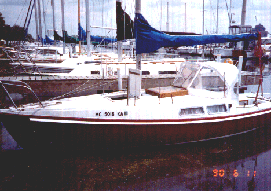

The 1966 Lapworth 24 Gladiator, "Zephyr", Hull # 71
In 1965, sixteen year old Robin Lee Graham began a solo around-the-world voyage from San Pedro, California, in his twenty-four foot sloop, the Lapworth 24, Dove. Five years and 33,000 miles later, he had accomplished what few had dared to attempt.That journey was well documented in the pages of National Geographic Magazine, and later in Graham's own book, "Dove".
Although he completed the last leg of his voyage in a larger Luders 33, Robin Lee Graham sailed three-quarters of the way around the world in a twenty-four foot boat without a two way radio, and without SatNav, GPS, Loran, EPIRB, or even a real life raft. That boat was the sister of the Lapworth 24 Gladiator. The hulls are the same, but Dove was the trunk cabin or cruising version of the Lapworth 24, and the Gladiator was the raised deck model.
More recently, Frank Guernsey sailed his Lapworth 24 Gladiator, "Cestus" from Redondo Beach, California to Punta del Este, Uruguay, via Cape Horn on a 128-day non stop voyage with no motor. See our links section below for information on Frank Guernsey's book, Racing the Ice to Cape Horn.
These fine rugged little boats can still be found. Restoration of a Lapworth 24 Gladiator may well be worth the effort as the photographs on this page document.
Photos of Zephyr and specifications courtesy of Captain Deborah Streeter. Photos of Zephyr: copyright by © Captain Deborah Streeter 2000, All rights reserved. Captain Deborah Streeter [mailto:capndeb@yahoo.com]
DESIGNER: William Lapworth N.A.
BUILDER: Continental Plastics, Costa Mesa, CA.
| Length: 24' | Beam: 8' | Draft: 4' | Ballast: 2050#lead | Displacement: 4500#app. | Bridge Clearance: 39' |
| SAIL AREA | Main: 204 sq. ft. | Jib: 118 sq. ft. | Genoa: 168 sq. ft. | Drifter: 229 sq. ft. | N/A |
| SPARS: | Aluminum | Mast: 31 ft. long | Boom: 12 ft. long | N/A | N/A |
| HULL | Solid molded fiberglass |
| DECK | Non skid molded fiber-glass with a double 1/2" ply- wood core separated with 1/4" fiberglass, total thickness 1 1/2" |
Full fixed keel with the ballast encapsulated, with a cutaway forefoot. The rudder is attached to the back of the keel.
Two opening hatches, one forward, hinged aft, one companionway slider of mahogany with drop boards. Deck hardware is through bolted with backup plates. Two single speed sheet winches. Jib sheet tracks with blocks & cleats, and main traveler.
7/8 rig with a jumper & double lower shrouds.
AUXILIARY
Outboard motor mounted on transom or inboard.
SS sink w/through hull drain and manual pump. Space for stove on counter top. Ice box. Storage under the bunks. Foam cushions with covers. marine head built into a well forward.
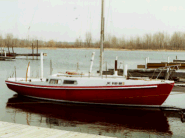
We bought her in 1972 and have sailed her regularly since. We have performed many major upgrades and added many conveniences and improvements over the years we have owned her. The reason we are selling her now is that because of business commitments we can only get away to sail about 4 or 5 weekends each summer and that light usage does not justify the slip rental. We have also sailed about every place we wanted to: Holland to Milwaukee & back, twice; Holland to Sault St. Marie & back, 3 times; the "North Channel" and last year we circumnavigated the Keewenaw Peninsula including "Isle Royale".
She is a very traditional looking boat with a standard transom and a modest bow & stern overhang. She is very pretty with her bright red hull and white deck. Because of her flush deck there isn't standing headroom below.
When she was designed and built sailboats were built to sail, not be a floating weekend cottage with sails. Over the years we have routinely sailed past everything up to about 32' despite their best efforts to prevent it. She isn't designed to beat a rule, just slide through the water easily, and that she does. When she was built resin cost a lot less so they used a lot of it in the construction. The hull is about 3/8" thick every place I've checked. The hull is a "Full Wine Glass" shape with very round bilges. She there-fore drops off to about a 15 degree angle of heel rather easily, then stiffens up at about 20 degrees. We have had her heeled over past 47 degrees in some really awful weather, the winches were awash but she kept sailing and refused to go over any further. She has about 36" of freeboard from the bow, back to the cockpit there it drops to about 24", so you don't feel like you're sitting on a roof.
All of the wood on and in the boat is Mahogany, except the rub rails which are laminated white oak bolted on 6" centers. All the hardware is Brass or Stainless Steel.
She is in sail away condition as she sits. We have owned her since 1972 and have replaced just about everything that can be replaced. She is a very fast and safe boat and she handles very solidly and reliably.
--- Owner of Hull #71
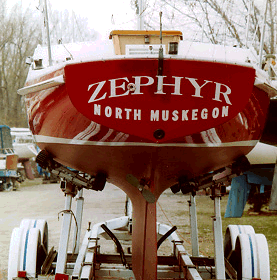
The Lapworth Gladiator has been a wonderful boat for me. Although I haven't traveled as far and as wide as the previous owners, I found her to be a very forgiving craft in which to learn to sail and hence to teach sailing. Her running rigging is currently color coded to make directions easy for novice sailors. Anything to do with the foresail is green or has green specs and anything to do with the mainsail, including reefing, is red or has red specs. Augmented by the presence of the tiller, in which you truly can feel the wind, she is a great teacher.
Out of curiosity, a certified PHRF was obtained in 1994, which put her the fifth slowest boat on Lake Michigan. Her base handicap was 270 and her racing/non-spinnaker handicap was 273. While racing in a few lo-key Sunday afternoon Conservation Club races she was able to beat Catalina 30s and Hunter 33s given a little wind. Light air days, we requested a saved seat at the pot-luck dinner.
---Owner of Hull #71
My dad was the original owner of the Lapworth 24 Gladiator, hull #21, "The Cestus", We sailed that boat all over the place and she was a real solid, fast boat. I recently ran into a man named Frank Guernsey, who had purchased "Cestus" and had sailed her from Redondo Beach, California, around the Cape Horn and up to Uruguay. The trip took him about 128 days, nonstop, no motor. He has a book out and a video, which is really thrilling. His voyage is documented in his book, "Racing the Ice To Cape Horn".
We originally bought the boat (brand new hull #21) from King Harbor Boats in Redondo Beach, California. The dealer, an old salt named Hugh Doherty really believed in the Gladiators and owned hull #100. I ended up working for him as a kid and watched the shop when he would race her. I remember he did a San Francisco to Newport race. We sailed and raced ours a lot, mostly on the coast of Southern California and Catalina Island. When we bought her, my Dad didn't think we needed anti-fouling paint--he was just going to dive down and clean the bottom. The first Catalina trip took about 12 hours to go 25 miles.
On the way back, after the bottom was cleaned, the trip took just under 4 hours on a reach with 15 knots of breeze. These boats are very solid, built back in the early days when no one was sure how much fiberglass to use, so they used a lot. They sail great and are easy to single hand.
At age 12, I took her out by myself everyday in the summer. When we bought ours they were manufactured by Continental Plastics in Costa Mesa, Calif. Around the early 70's Gulf Marine bought the molds and was making them. I guess they eventually went out of business, but I'm not sure when. As you know, the hull was a Lapworth 24, with a flush deck.
The builder put 2000 lbs of lead in the keel and I was told they moved the lead a little farther forward in the keel than the Lapworth, which made it go faster and really surf with a following sea. A couple of kids sailed a Lapworth to Hawaii from California in 19 days, as stated on the original Gladiator brochure. This was quite a while before the Dove adventure.
We really loved the "Cestus" and sailed the hell out of her from 1963 to about 1975. Imagine my surprise in 1995 when I met Frank at a yacht club and we got to talking about boats and he told me all about the adventure he had with our old boat, the "Cestus". At the time, I was having the typical buyers remorse about the boat I had just bought, an O'Day 27 (turned out to be another great one), but after talking to Frank, I knew there was some karma working there and it was meant to be. I would most definitely recommend the Gladiator to anyone thinking about buying a good used boat."
---Phil Jay phil.jay@valleyair.org
Editor's note: See links to Frank Guernsey's book about the voyage of "Cestus", hull # 21 from California to Uruguay.
Information on and Photos of Individual Lapworth 24 Gladiators
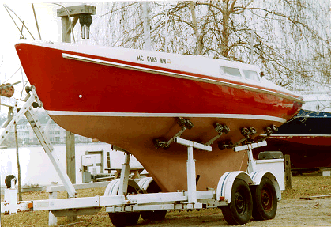
In addition to the standard features, Zephyr was equipped with the following features:
Full length white oak rub rails with brass faces. Four Marelon through hull fittings, Propane locker vent, sink drain with sea-cock, engine coolant intake with seacock, cockpit drain with sea-cock. Through hull for knot meter. Full fixed keel with the ballast encapsulated, with a cutaway forefoot.Hull painted red with DuPont Imron.
Mast is tabernacle stepped on deck. Mainsail is equipped with "Jiffy Reefing". Mainsail cover. Spinnaker track on mast. One main and 2 jib halyards with holdoffs. Downhaul control for Mainsail. Boom vang.
Solar vent on front hatch. Screens for both hatches. Full width spray dodger. Deck hardware is through bolted with backup plates. Two single speed sheet winches. Jib sheet tracks with blocks & cleats. Mainsheet track with ball bearing car and blocks. Numerous dock lines. Dock line chocks - 2 bow & 2 stern. Cleats: 2 bow, 2 stern, 2 amidships. Turning blocks for the drifter. Fuel fill deck plate. Anchor chain deck pipe. Flagstaff & flag.
SS bow pulpit w/ anchor holder. 6 SS stanchions w/ double lifelines. 1500 GPH electric bilge pump. 2 lb. Dry Chemical fire extinguisher. 13 lb. Danforth anchor w/ 150' of nylon line & 6' of chain. 2 "Jim Buoy" safety harnesses. 4 PFD safety vests & 2 cushions. Air Horn. Flares (probably out-dated). Propane locker is sealed inside & vented over- board.
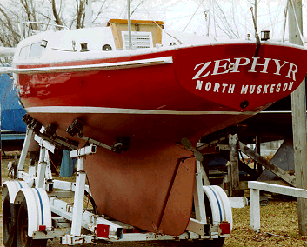
5" Danforth "Constellation" compass. Auto-Helm 2000 autopilot. VHF radio w/ mast antenna. Depth sounder - not reliable. Wired for 110v & 12v. 6 overhead reading lights (12v). 50' shore power cord.
Two burner propane stove, built into counter top. Ice box, built in with 3" foam insulation. Dishes & mugs in a Mahogany rack. Storage behind the bunks. 4" thick foam cushions w/fabric covers. Port-a-Potti built into a well forward.
Zephyr was equipped with a 20 Hp. Arnolt "SEAMITE" gasoline inboard engine. Lighted instrument panel. Reverse gear with no reduction. "Morse" engine controls. Two blade brass propeller. 12" dia x 13" pitch. "Last Drop" shaft seal. Waterlift muffler. Electric fuel pump. 12 Gal. fuel tank w/2 filters, 2 shut-offs. Fuel consumption's is 1/2 gal/hr @ 6 knots giving a range of over 140 miles.
The bottom paint on the boat as photographed is VC-17, which turns gray after the boat has been launched and is sitting in the water. It is a "go-fast" paint that can be used in fresh water.
"Bambino" owned by Joseph V. De Michele
Lapworth 24 Gladiator Brochure
The four pages of a 1960s Gladiator brochure published by Continental Plastics are on a separate page linked to this page through this link or through the thumbnail sketches below. The photographs and text of the brochure were provided in the original format by Phil Jay, who wrote testimonial #3 above about the Lapworth Gladiator "Cestus, hull #21.The text has been presented in text form rather than in image format to reduce loading time and to improve the readability of the text on-line.
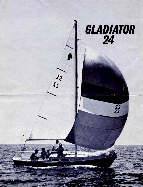
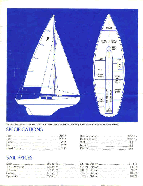
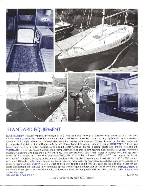
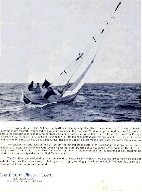
Lapworth 24 and Lapworth 24 Gladiator Links
Copyright © by Scott Galloway 2000. All rights are reserved.
Zephyr photos: copyright by © Captain Deborah Streeter 2000. All rights reserved

Return to Solo Publications Web Index
Back To The Table of Contents
This page was created by myrmade@solopublications.com